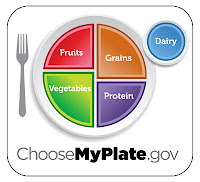I often get asked for help with serving sizes, so here are some guidelines to help in each healthy food category.
I hate to break it to you, but you can’t eat one baby carrot and call it a vegetable serving. 🙂
Fruits: One serving of fruit is 1/2 cup of fruit or 100% fruit juice, or 1/4 cup of dried fruit (dried fruit coated in sugar does not count). I know sometimes it can be tricky to decide what counts as a serving because fruit comes in so many different shapes and sizes. Generally, one large whole fruit the size of a tennis ball = 1 cup or 2 servings.
Vegetables: One serving of vegetables is 1/2 cup raw or cooked veggies or vegetable juice or 1 cup leafy raw veggies.
Protein: One serving equals 15 grams of protein. 60 or more grams required daily. See {this} blog post for examples.
Fiber: One serving of fiber is 8-10 grams. 25 or more grams required daily. You can read more about the amount of fiber in different foods {here}.
Find a printable version of this guide {here}.
Remember too, that foods can count in multiple categories! For example, fruit and veggie servings count toward your fiber servings. See more about double duty foods {here}.
I hope that is helpful! Here are some more resources if you need them…
www.webmd.com {This one has some great visuals}


Tiffany,
I was on http://www.choosemyplate.gov today and noticed the serving sizes for vegetables are different than what you have posted on the blog. They use 1 C for a serving and 2 C of raw leafy greens. What do you want us to consider as a serving?
Also, for protein it should be 1/4 C cooked beans, not dry.
Jenn, thanks for letting me know. I just checked my links again and you’re right. The funny thing is that those two websites are where I got this info originally and they have changed since January! 🙂
After looking over them again though, I do still think I’ll stick with these numbers. The reason I decided that is because http://www.choosemyplate.gov lists 1 cup as the vegetable serving size, but recommends you get 2 1/2 cups per day. Since the challenge requires 4 servings – you end up at the same total amount.
Beans are similar, but opposite. They recommend 5 “ounce equivalents” and the challenge only requires 2, so the bigger serving size helps make up for that.
Funny how things are always changing in nutrition, huh?! I figure that the main goal is eating more fruits and veggies and a bigger variety of foods and hopefully the challenge helps people reach that goal, even if it isn’t an exact science.
I hope my crazy long novel answered your question! 🙂